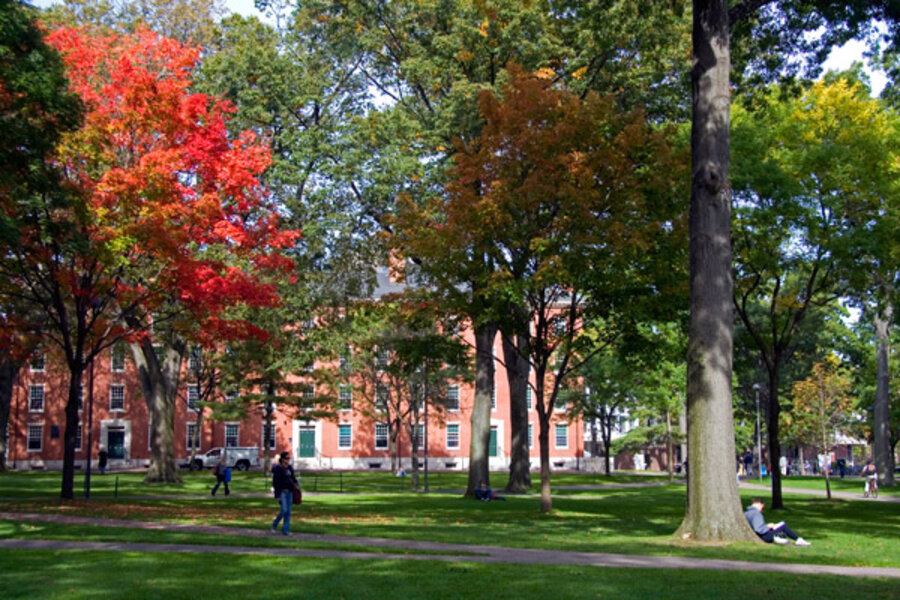Do you have to be a math whiz to understand 'Best College' rankings?
Loading...
So, how does U.S. News & World Report decide that Harvard and Princeton rank as America's top "national universities"?
True to form, the news magazine's annual ranking of the best colleges, released Tuesday, is top-heavy with Ivy League schools. (Harvard and Princeton tied for the coveted No. 1 spot, and the six other "ivies" also made the grade.) And while the rest of the list also contains few surprises, the exhaustive methodology behind the rankings is shrouded in a bit more mystery.
Since its first ranking was published in 1983, the magazine has used a three-step process to compile its lists. Here's how:
1. Schools are categorized by type of institution
Thousands of schools are sorted into four main types of institutions: national universities, national liberal arts colleges, regional universities and regional colleges.
According to the U.S. News website, "national universities" offer a full range of undergraduate majors plus master’s and Ph.D. programs, and emphasize faculty research.
"National liberal arts colleges" focus almost exclusively on undergraduate education, awarding at least half of their degrees in the arts and sciences.
"Regional universities" offer a broad scope of undergraduate degrees and some master’s degree programs, but few doctoral programs.
"Regional colleges" focus on undergraduate education but award less than half of their degrees in liberal art disciplines. These schools may also have small bachelor’s degree programs but primarily grant two-year associate degrees.
"Regional universities and colleges" are further divided and ranked by their locations: North, South, Midwest and West.
There are also subsequent specialty rankings of certain undergraduate program areas, such as art, business, and engineering.
2. Academic quality is assessed, using data gathered primarily from three major sources
The magazine collects data via surveys sent to the colleges themselves, to faculty members and administrators who are from different colleges, and from high school counselors. It also uses data collected from the colleges' websites. There are as many as 16 indicators of academic quality, which fall into a number of categories:
- Undergraduate academic reputation. Data collected from surveys of presidents, provosts, deans of admissions, and high school and college counselors counts for between 22.5 percent and 25 percent of the academic quality assessment.
- Retention rate of freshmen. The rate at which freshmen return to campus sophomore year and eventually graduate counts for between 20 percent and 25 percent, depending on the type of the institution.
- Faculty resources. The amount of face time students get with professors, class size, and faculty salary count for 20 percent.
- Student selectivity. Enrolled students’ SAT or Composite ACT scores, their high school class ranks, and the institution's acceptance rate together count for 15 percent.
- Financial resources. The average amount a student spends on instruction, research, student services, and related educational expenses counts for 10 percent.
- Graduation rate. The predicted graduation rate of classes counts for 7.5 percent for national universities and national liberal arts colleges only.
- Alumni giving. The average annual percentage of alumni with bachelor’s degrees who gave to their school counts for 5 percent.
3. Schools are ranked in their category by a total weighted score
The rankings are published every year in lists on the U.S. News & World Report website (and, of course, in its print magazine). Though the methodology may boggle the mind of the average citizen, the process has its critics, many of whom argue it is too superficial or weights the wrong things.
Here’s the list of the 2011 Top 20 "national universities." (For those who need help recognizing the Ivy League schools, look for the asterisks.)
1. *Harvard University (tie)
1. *Princeton University (tie)
3. *Yale University
4. *Columbia University
5. The California Institute of Technology (tie)
5. Massachusetts Institute of Technology (tie)
5. Stanford University (tie)
5. University of Chicago (tie)
5. *University of Pennsylvania (tie)
10. Duke University
11. *Dartmouth College
12. Northwestern University
13. Johns Hopkins University
14. Washington University in St. Louis
15. *Brown University
16. *Cornell University
17. Rice University (tie)
17. Vanderbilt University (tie)
19. University of Notre Dame
20. Emory University





